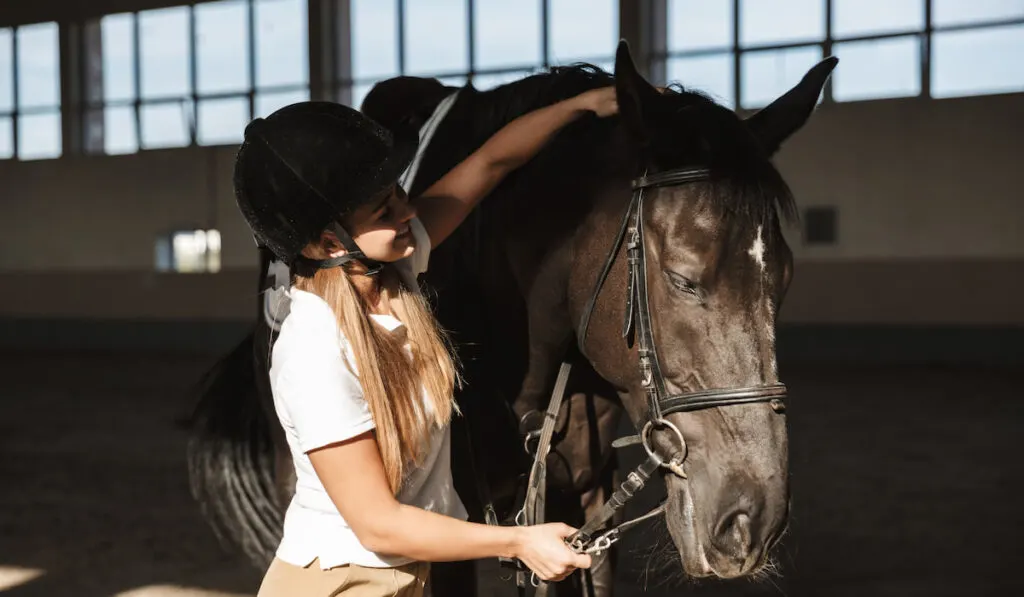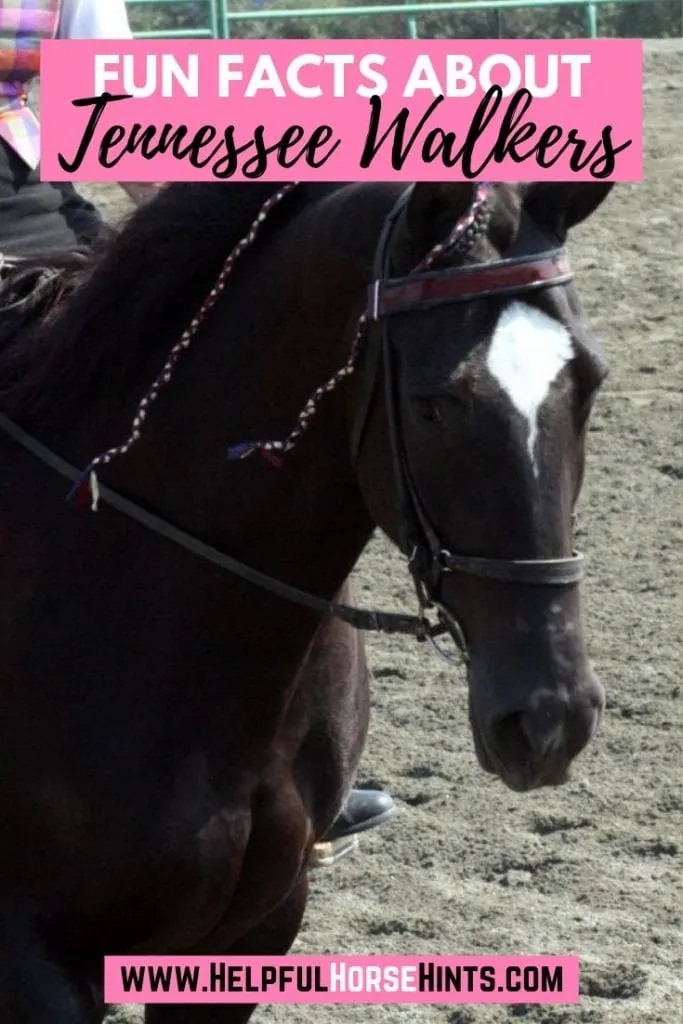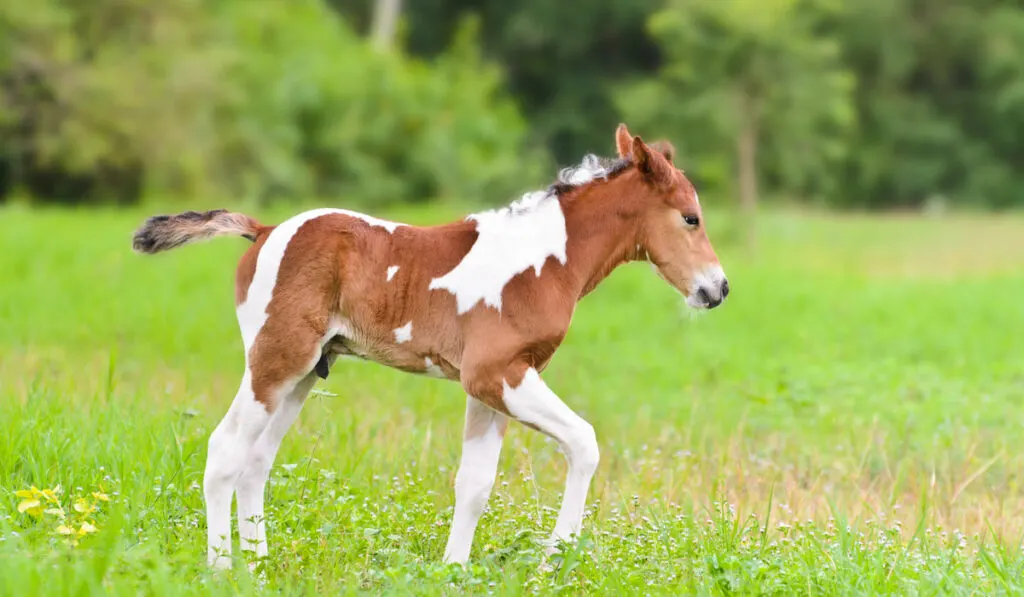The Tennessee walking horse is one of the most misunderstood and controversial horse breeds in the equine world. Named for its birthplace in the hills of Tennessee, this American horse is easy-going, utilitarian, and a pleasure to ride. Here are 11 things you probably didn’t know about the Tennessee Walking Horse.
Table of Contents
They’re an all-American breed!
Tennessee walking horses (often abbreviated as Tennessee Walkers or TWH) developed by crossing Narragansett pacers with Canadian pacers and gaited Spanish mustangs.
Plantation owners and farmers needed a comfortable horse that could cross miles of plantation easily, provide a smooth and comfortable ride, and remain surefooted on the rocky landscape.
After adding some athletic standardbreds, flashy American Saddlebreds, speedy thoroughbreds and versatile Morgan horses to the pedigree, the TWH was born.

The first foundation sire was a failure.
Black Allen began his career as a trotting racehorse, but he generally finished last because he preferred to pace instead. He could also perform the running walk: a trait he passed to his offspring – including the talented Roan Allen. Roan Allen could perform 7 gaits on command, and he is considered the father of all modern Tennessee walking horses.
The studbook was closed in 1947.
A Tennessee walking horse may only be registered with the Tennessee Walking Horse Breeders’ and Exhibitors’ Association if both of its parents are registered Tennessee walking horses.
If the pedigrees of the parents are unknown, the foal can’t be registered as purebred. In 2007, DNA testing was implemented to further secure the purity of TWH bloodlines.
They’ll be your buddy for life.
Tennessee Walkers are famous for their easy-going and docile natures. They’ll be cool as cucumbers in the show ring, and bomb-proof out on the trail.
They may be warmbloods, but their calm personalities closely resemble those of their more cold-blooded draft cousins. A healthy walker can live up to 30 years with proper care and attention.

They have a truly unique “walk.”
Tennessee walking horses are a gaited breed – their movements differ from the straightforward walk, trot, and canter. Instead, a TWH will perform a flat walk, “running walk”, and canter (though they may also perform a standard trot, foxtrot, stepping pace, or single-foot running walk).
The running walk sets the breed apart from other horses, but it also sets them apart from other gaited breeds. Here’s a breakdown of different horse gaits:
| Tennessee Walking Horse | Non-gaited horse |
| Flat foot walk: 4 beats. Each foot strikes the ground separately at regular intervals, long-reaching stride, 4-8mph. | Walk: 4 beats. Each foot strikes the ground separately at regular intervals, 5 mph. |
| Running walk: 4 beats. Gliding gait, 10-20 mph, nods head in rhythm, comfortable and easy to sit. | Trot: 2 beats. Feet land in diagonal pairs, 8 mph, bouncy, hard to sit, riders often forced to post. |
| Canter: 3 beats. Controlled, 10-20 mph, propelled by one back leg, comfortable “rocking chair” motion | Canter: 3 beats. Controlled, propelled by one back leg, 10-20 mph, can be bouncy and hard to sit. |
When a TWH walks, the hind feet will strike farther than the front footsteps in an “overstride.” In the running walk, the back feet glide forward and will overstep the footprints of the front feet by about 6 – 18 inches. The horse will also bob its head in rhythm with its feet. The large overstride and the head-nodding are distinctive characteristics of the Tennessee walking horse breed.

They’re not all show horses: most are bred for comfort and utility.
There are two categories of TWH show competition: “flat-shod” and “performance”. Performance horses appear in the show ring with action devices on their feet: large built-up pads (or stacks), chains, or other weighted devices. These devices encourage the horse to lift its feet higher in an exaggerated “big lick” style of the running walk.
Flat shod horses wear regular shoes and perform a less exaggerated, natural running walk. Good form is most important: not speed.
Most Tennessee walkers are shown by owners and trainers who prize the horse’s natural flashy action and not the artificially exaggerated gait of big lick horses: only 10% of Tennessee walking horses appear in performance classes.
They were born to run – running walk, that is!
Because the running walk is so unique to the Tennessee walker, it may look odd or wrong to the untrained eye. Some people think that the running walk is artificial. This is simply untrue: these horses are genetically predisposed to perform this gait.
The exaggerated high steps in the performance horse show ring are boosted by artificial means, but the running walk itself is something that colts do in the pasture on their own. A standard flat-shod TWH is trained like any other horse under saddle – with repetition, patience, and lots of treats and praise!

They’re Controversial.
As the TWH competition field narrowed, trainers began to take shortcuts to achieve the “animation and accentuated brilliance” of performance horses.
- Soring is the abusive practice of applying a caustic agent to sensitize a horse’s front legs: drain cleaner, diesel fuel, or mustard oil. Action devices (thick pads nailed to the horse’s feet or rolling ankle chains) add pressure to the damaged limbs, and the horse lifts its feet to escape the pain.
In an effort to end soring, Congress passed the Horse Protection Act of 1970: it is unlawful for any person to sell, show, exhibit, or transport a horse that has been sored.
Equine activists argue that the HPA doesn’t go far enough. Several bills were proposed to amend the HPA. The most recent is the “Prevent All Soring Tactics” act. The PAST act would:
- Implement USDA inspectors at horse shows and end the self-policing system of third-party inspectors.
- Strengthen penalties for soring: the act itself would become illegal.
- Ban the use of action devices.
Opponents to the PAST act, including the Tennessee Walking Horse Breeder’s & Exhibitors’ Association, are concerned that this bill “would decimate the show industry and serve as a launchpad for restrictive legislative attacks on other breeds that also show or exhibit”:
| Arguments Against the PAST act | Arguments For the PAST act |
| It would create an economic hardship for trainers, show organizers, breed enthusiasts by ending competitions. | Flat-shod and humane competitions would still be allowed. The actions of abusive trainers should not be rewarded with ribbons. |
| The TWH industry is self-policing with a high rate of compliance. | The compliance calculation is faulty: the rate of sored horses is statistically much higher than is being reported. |
| The breed will be destroyed. | Breed enthusiasts can still humanely train and show their horses, thus bolstering the breed and removing this “black stain of abuse” from the industry. |
| Horseshoes are necessary for the health of a horse’s feet. | Not all shoes are banned under this bill. Therapeutic or protective shoes are always allowed. Only shoes that are intended to change a horse’s natural gait are banned. |
| The bill should be science-based, objective, and not be an overreach from the government. | This bill is science-based, objective, and the industry hasn’t fixed the problems in 40 years: it’s time for the government to step in once again. |
There are over 250 endorsements for the PAST act, from horse welfare organizations to veterinarians and celebrities. No matter which side you’re on, everyone agrees that soring is a barbaric practice that should be stopped, for good. (source)
They’re best known for their running walk, but there are Tennessee walkers in all disciplines.
The Tennessee Walking horse was bred for utility, and breed enthusiasts specifically wanted an animal that could excel in a wide range of disciplines. (source)
The “all-terrain vehicles” of the equine world, Tennessee walking horses excel on trails. However, they can also be used for eventing, parades, roping, cutting, barrel racing, jumping or even dressage!
They may struggle with specific events due to their unique way of moving and conformation, but a Tennessee walker is often willing to try anything.
They’re Famous!

There are many uncredited Tennessee walking horses on the silver screen; their smooth gaits are easy for a non-horseman to ride, and their docile personalities make them perfect for the hustle and bustle of a movie set.
Some famous walkers stand out:
- Trigger Jr: While Roy Roger’s famous horse “Trigger” was actually a thoroughbred cross, Trigger Jr. was a full-blooded TWH named Allen’s Gold Zephyr. Well-versed in rodeo tricks, Trigger Jr. replaced Trigger when he retired.
- Silver: The Lone Ranger’s famous mount was played by many walkers over the years, including Silver King, Silver Chief, and White Cloud.
- Champion: This stallion toured the US and made personal appearances with “America’s Favorite Singing Cowboy” of the late 1940s, Gene Autry.
They Are Extremely Comfortable to Ride
Walkers are famous for their smooth ambling gaits. They glide forward effortlessly to cover miles of bumpy terrain. Because of this, a calm Tennessee Walker is often a great choice for a beginner or a rider with joint problems. If you’ve had trouble in the past with a standard trotting horse, consider trying a Tennessee Walking horse. You’ll be glad you did!
If you are interested in learning more about other horse breeds, check out these articles:
Source:
https://www.geneautry.com/geneautry/champion/lindychampion.html


